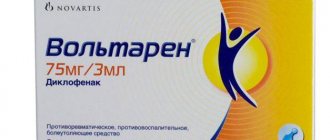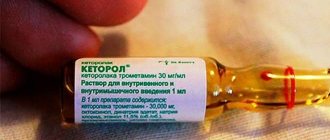Eplerenone (tablet form) belongs to the group of diuretics. Important features of the drug from the instructions for use:
How to dissolve vascular plaques, normalize blood circulation, blood pressure and forget the way to the pharmacy
- Sold only with a doctor's prescription
- During pregnancy: with caution
- When breastfeeding: contraindicated
- In childhood: contraindicated
- For liver dysfunction: with caution
- If renal function is impaired: with caution
- In old age: with caution
Package
The drug Eplepres is a diuretic, potassium-sparing drug.
Eplerenone has relative selectivity in binding to recombinant human mineralocorticoid receptors compared to its interaction with recombinant human glucocorticoid, progesterone and androgen receptors. Eplerenone prevents the binding of receptors to aldosterone, an important hormone of the renin-angiotensin-aldosterone system, which is involved in the regulation of blood pressure and is involved in the pathophysiological mechanisms of the development of cardiovascular diseases. Eplerenone leads to a persistent increase in plasma renin and serum aldosterone levels, which coincides with inhibition of the negative feedback pathway of aldosterone on renin secretion. At the same time, an increase in the activity of renin in the blood plasma and the level of aldosterone in the blood does not lead to inhibition of the effect of eplerenone. In chronic heart failure (NYHA classes II-IV), the inclusion of eplerenone in the standard treatment regimen led to the expected dose-dependent increase in aldosterone levels. The studies did not reveal a consistent effect of eplerenone on heart rate, QRS duration, or PR and QT intervals. Children. Eplerenone has not been studied in children with heart failure. There have been no studies of any (long-term) effects on the hormonal status of children. Pharmacokinetics. Absorption. The absolute bioavailability of eplerenone is unknown. The maximum concentration of the drug in the blood plasma is reached after approximately 2 hours. The maximum plasma concentration (Cmax) and area under the pharmacokinetic curve (AUC) vary dose proportionally in the range of 10-100 mg and are less than dose proportional at doses above 100 mg. The equilibrium state occurs within 2 days from the start of treatment. Food does not affect the absorption of the drug. Distribution. Eplerenone is approximately 50% bound to plasma proteins and mainly to α1-acid glycoproteins. The estimated volume of distribution of eplerenone at steady state is estimated to be 50 ± 7 L. Eplerenone does not tend to bind to red blood cells. Biotransformation. Eplerenone is metabolized primarily by the CYP3A4 enzyme. No active metabolites of eplerenone have been identified in human plasma. Excretion. Less than 5% of an eplerenone dose is excreted as unchanged drug in the urine and feces. Following oral administration of a single dose of radiolabeled drug, approximately 32% of the dose was excreted in the feces and approximately 67% in the urine. The half-life of eplerenone is approximately 3-5 hours. The estimated plasma clearance is approximately 10 L/hour.
Indications for use:
Indications for use of the drug Eplepres are:
—Addition to standard treatment using beta blockers to reduce the risk of morbidity and mortality associated with cardiovascular disease in stable patients with left ventricular dysfunction (left ventricular ejection fraction ≤ 40%) and clinical signs of heart failure after a recent infarction myocardium.
—Addition to standard optimal therapy to reduce the risk of morbidity and mortality associated with cardiovascular disease in adult patients with NYHA class II (chronic) heart failure and left ventricular dysfunction (left ventricular ejection fraction ≤ 30%).
Indications for use
- Myocardial infarction: in addition to standard therapy to reduce the risk of cardiovascular mortality and morbidity in patients with stable left ventricular dysfunction (ejection fraction less than 40%) and clinical signs of heart failure after myocardial infarction;
- Chronic heart failure: in addition to standard therapy to reduce cardiovascular mortality and morbidity in patients with NYHA class II chronic heart failure with reduced left ventricular ejection fraction (<35%).
Mode of application
Eplepres can be taken with or without food (see section “Pharmacokinetics”). The maximum daily dose of the drug is 50 mg per day.
Patients with heart failure after myocardial infarction. The recommended maintenance dose of eplerenone is 50 mg once daily. Treatment should begin with a dose of 25 mg once daily and gradually increase to a target dose of 50 mg once daily. It is advisable to achieve this dose level within 4 weeks, taking into account serum potassium levels (see table below). Treatment with eplerenone, as a rule, should be started 3-14 days after acute myocardial infarction.
Patients with NYHA class II (chronic) heart failure. Treatment of patients with NYHA class II chronic heart failure should begin with a dose of 25 mg once daily and gradually increase to a target dose of 50 mg once daily. It is advisable to achieve this dose level within 4 weeks, taking into account the level of potassium in the blood serum (see table below and section “Peculiarities of use”). Patients whose serum potassium levels exceed 5 mmol/L should not begin treatment with eplerenone (see Treatment of Oncology
in
Germany
Leading specialists
Germany
.
Free consultation! We speak Russian! Leading specialists from Germany
. Free consultation! We speak Russian!dk-allianz.deOnasClinicsPricesReviewsOnasClinicsPricesReviewsdk-allianz.deGoAdvertisingHide adThere are contraindications. Consult a doctor. There are contraindications. Consult a doctor. section "Contraindications"). Serum potassium levels should be determined before initiation of eplerenone treatment, during the first week of treatment, and one month after initiation of treatment or dose adjustment.
After temporary withdrawal of eplerenone due to an increase in potassium levels to 6 mmol/l, resumption of treatment is possible at a dose of 25 mg once every 2 days after the potassium concentration decreases below 5 mmol/l.
Elderly patients: For elderly patients, there is no need to adjust the initial dose of the drug. Due to age-related decline in renal function, the risk of developing hyperkalemia in elderly patients increases. The risk may be further increased in the presence of a concomitant disease that is accompanied by an increase in systemic exposure to the drug, in particular mild to moderate liver dysfunction. It is recommended to periodically monitor the level of potassium in the blood serum (see section “Peculiarities of use”). Renal dysfunction.
Patients with mild renal impairment do not require adjustment of the initial dose. It is recommended to periodically monitor the level of potassium in the blood serum (see section “Peculiarities of use”) and adjust the dose of the drug in accordance with the table above.
Patients with moderate renal impairment (creatinine clearance 30-60 mg/ml) should begin treatment with a dose of 25 mg once every 2 days and adjust the dose of the drug depending on the potassium concentration (see table above). It is recommended to periodically monitor the level of potassium in the blood serum (see section “Peculiarities of use”). There is no experience with the use of the drug in patients with creatinine clearance <50 ml/min and heart failure after myocardial infarction. Eplerenone should be used with caution in these patients. Doses exceeding 25 mg per day have not been studied in patients with creatinine clearance <50 ml/min. Eplerenone is contraindicated in patients with severe renal impairment (creatinine clearance <30 ml/min) (see section "Contraindications"). Eplerenone is not removed from the body by dialysis.
Patients with mild or moderate hepatic impairment do not require adjustment of the initial dose, however, due to the increased level of systemic exposure to eplerenone in this category of patients and especially elderly patients, frequent and regular monitoring of serum potassium concentration is recommended (see section "Peculiarities of Application" ). Combined use. In case of simultaneous use with weak or moderate CYP3A4 inhibitors (for example, amiodarone, diltiazem and verapamil), treatment with eplerenone can be started with an initial dose of 25 mg 1 time per day. The dose of the drug should not exceed 25 mg 1 time per day (see section “Interaction with other drugs and other types of interactions”). Children. The safety and effectiveness of eplerenone in children have not been established. Currently available information is given in the sections “Pharmacodynamics” and “Pharmacokinetics”.
Side effects:
From the blood and lymphatic system: eosinophilia.
From the endocrine system: hypothyroidism.
From the nervous system: dizziness, syncope, headache, hypoesthesia.
From the cardiovascular system: myocardial infarction, left ventricular failure, atrial fibrillation, tachycardia, arterial hypotension, thrombosis of the arteries of the extremities, orthostatic hypotension.
From the respiratory system, chest and mediastinum: cough.
From the gastrointestinal tract: diarrhea, nausea, constipation, vomiting, bloating.
From the skin and subcutaneous tissues: rash, itching, hyperhidrosis, angioedema.
From the musculoskeletal system and connective tissues: muscle spasms, pain in the musculoskeletal system, back pain.
From the kidneys and urinary tract: impaired renal function (see sections “Peculiarities of application” and “Interaction with other drugs and other types of interactions”).
From the liver and biliary tract: cholecystitis.
From the reproductive system and mammary glands: gynecomastia.
From the mental side: insomnia.
From the side of metabolism and digestion: hyperkalemia (see sections “Contraindications” and “Peculiarities of use”); hyponatremia, dehydration, hypercholesterolemia, hypertriglyceridemia.
General disorders: asthenia, malaise.
Infections and infestations: infection, pyelonephritis, pharyngitis.
Laboratory tests: increased blood urea levels, increased creatinine levels, decreased epidermal growth factor receptors, increased blood glucose levels.
Inspra
Potassium-sparing diuretic. Eplerenone has high selectivity for mineralocorticoid receptors in humans, in contrast to glucocorticoid, progesterone and androgen receptors, and prevents the binding of mineralocorticoids to aldosterone, a key hormone of the renin-angiotensin-aldosterone system (RAAS), which is involved in the regulation of blood pressure (BP) and the pathogenesis of heart disease. -vascular diseases.
Eplerenone causes a persistent increase in the activity of renin in the blood plasma and aldosterone in the serum. Subsequently, renin secretion is suppressed by aldosterone via a feedback mechanism. However, an increase in renin activity or circulating aldosterone concentration does not affect the effects of eplerenone.
The effectiveness of eplerenone was studied in the double-blind, placebo-controlled EPHESUS study (Eplerenone Postacute myocardial infarction Heart failure Efficacy and Survival Study) in 6632 patients with acute myocardial infarction (MI), left ventricular (LV) dysfunction (ejection fraction (EF) <40%) and with clinical signs of heart failure. For 3–14 days (mean 7 days) after acute myocardial infarction, patients were prescribed eplerenone or placebo in addition to standard therapy. Treatment began with a dose of 25 mg once a day and was increased to 50 mg once a day by the end of 4 weeks if the serum potassium level remained less than 5 mmol/l. During the study, patients received standard therapy using acetylsalicylic acid (92%), ACE inhibitors (90%), beta-blockers (83%), nitrates (72%), loop diuretics (66%) or 3-hydroxy inhibitors -3-methylglutaryl coenzyme A reductase (HMG-CoA reductase) (60%). The primary endpoint of the study was overall mortality, and the composite endpoint was death or hospitalization for cardiovascular disease. Eplerenone treatment reduced the risk of all-cause mortality by 15% (relative risk, 0.85; 95% confidence interval (CI), 0.75-0.96; p=0.008) compared with placebo, primarily due to a reduction in cardiovascular mortality . The risk of death or hospitalization for cardiovascular disease was reduced by 13% with eplerenone (relative risk, 0.87; 95% CI, 0.79-0.95; P=0.002). The absolute risk reductions for the two endpoints—all-cause mortality and cardiovascular mortality/hospitalization—were 2.3% and 3.3%, respectively.
The clinical trial EMPHASIS-HF (Eplerenone in Mild Patients Hospitalization And SurvIval Study in Heart Failure) included 2,737 patients with chronic heart failure (CHF) functional class II (FC) according to the NYHA (New York Heart Association) classification and severe systolic dysfunction (mean LVEF in the study was 26.1%). The average follow-up period was 21 months. In the active treatment group with eplerenone, before inclusion, patients were taking ACE inhibitors or angiotensin II receptor blockers (94%), beta-blockers (86.6%). Primary endpoint: death from cardiovascular causes or hospitalization for heart failure (HF). The EMPHASIS-HF clinical trial demonstrated that the use of eplerenone at an average dose of 39.1±13.8 mg/day (25-50 mg) in patients with NYHA class II CHF reduced cardiovascular disease-related mortality by 37% (p<0.001) ). Clinical efficacy has been demonstrated primarily with eplerenone in patients under 75 years of age. The effectiveness of therapy in patients over 75 years of age has not been studied.
Electrocardiography
In studies studying ECG dynamics in healthy volunteers, no significant effect of eplerenone on heart rate (HR), the duration of the QRS, PR or QT intervals was detected.
Pharmacokinetics
Suction and distribution
The absolute bioavailability of eplerenone is 69% after taking 100 mg eplerenone orally in tablet form. The maximum plasma concentration (Cmax) is reached after approximately 2 hours. Cmax and the area under the concentration-time curve (AUC) depend linearly on the dose in the range from 10 to 100 mg and nonlinearly at doses greater than 100 mg. The equilibrium state is achieved within 2 days. Eating does not affect absorption.
Eplerenone is approximately 50% bound to plasma proteins, predominantly to the alpha1-acid group of glycoproteins. The calculated Vd at equilibrium is 50 (±7) l. Eplerenone does not bind to red blood cells.
Metabolism and excretion
Metabolism of eplerenone is carried out mainly under the action of the CYP3A4 isoenzyme. Active metabolites of eplerenone in blood plasma have not been identified.
Less than 5% of the eplerenone dose is excreted unchanged through the kidneys and intestines. After a single oral dose of labeled eplerenone, about 32% of the dose was excreted through the intestines and about 67% through the kidneys. T1/2 of eplerenone is about 3-5 hours, plasma clearance is approximately 10 l/hour.
Pharmacokinetics in special groups of patients
Age, gender and race: The pharmacokinetics of eplerenone 100 mg once daily have been studied in elderly patients (over 65 years of age), men and women. The pharmacokinetics of eplerenone did not differ significantly between men and women. At steady state, in elderly patients, Cmax and AUC were 22% and 45% higher, respectively, than in young patients (18-45 years).
The pharmacokinetics of eplerenone were studied in patients with renal failure of varying severity and in patients on hemodialysis. Compared with patients in the control group, patients with severe renal failure showed an increase in steady-state AUC and Cmax by 38% and 24%, respectively, and in patients on hemodialysis, their decrease by 26% and 3%. No correlation was found between the clearance of eplerenone from blood plasma and QC. Eplerenone is not removed by hemodialysis.
The pharmacokinetics of eplerenone at a dose of 400 mg were compared in patients with moderate hepatic impairment (Child-Pugh score 7-9) and healthy volunteers. Steady-state Cmax and AUC of eplerenone were increased by 3.6% and 42%, respectively. Eplerenone has not been studied in patients with severe hepatic impairment, and therefore its use in this group of patients is not indicated.
The pharmacokinetics of eplerenone at a dose of 50 mg was studied in patients with heart failure (FC II-IV). Steady-state AUC and Cmax in patients with heart failure were 38% and 30% higher, respectively, than in healthy volunteers matched by age, body weight and gender. The clearance of eplerenone in patients with heart failure is similar to that in healthy elderly people.
Contraindications
Contraindications to the use of the drug Eplepres are:
- Hypersensitivity to eplerenone or to any of the excipients.
- Serum potassium level > 5 mmol/l at the start of treatment.
— Severe renal failure (estimated glomerular filtration rate <30 ml/min/1.73 m2).
- Severe liver failure (class C according to the Child-Pugh classification).
- Treatment with potassium-sparing diuretics, potassium supplements or strong CYP3A4 inhibitors (for example, itraconazole, ketoconazole, ritonavir, nelfinavir, clarithromycin, telithromycin and nefazodone) (see section "Interaction with other medicinal products and other types of interactions").
- Simultaneous use of eplerenone in triple combination with an ACE inhibitor and an angiotensin receptor blocker.
Pregnancy
adequate data regarding the use of Eplepres in pregnant women.
Information obtained from animal studies does not indicate a direct or indirect adverse effect on the course of pregnancy, embryonic and fetal development, childbirth and postpartum development.
Eplerenone should be administered to pregnant women with caution.
It is unknown whether eplerenone passes into human breast milk after oral administration. Since the potential for side effects in breastfed infants has not been studied, a clinical decision should be made to discontinue breastfeeding or discontinue use of the drug depending on the importance of treatment to the woman.
Interaction with other drugs
Potassium-sparing diuretics and potassium supplements. Eplerenone should not be administered to patients receiving other potassium-sparing diuretics or potassium supplements due to the increased risk of hyperkalemia (see Contraindications). Potassium-sparing diuretics may also enhance the effect of antihypertensive drugs and other diuretics. ACE inhibitors, angiotensin receptor blockers. When eplerenone is used in combination with an ACE inhibitor and/or angiotensin receptor blocker, the risk of hyperkalemia may be increased. Close monitoring of serum potassium levels and renal function parameters is recommended, especially in patients at risk of renal impairment, such as the elderly. Eplerenone should not be used simultaneously in triple combination with an ACE inhibitor and an angiotensin receptor blocker (see sections “Contraindications” and “Peculiarities of use”). Lithium. Interaction studies between eplerenone and lithium have not been conducted. However, cases of toxic effects of lithium have been described in patients who received lithium simultaneously with ACE inhibitors and diuretics (see section “Peculiarities of use”). The simultaneous use of eplerenone and lithium preparations should be avoided. If it is not possible to avoid the use of this combination, it is necessary to monitor the level of lithium in the blood plasma (see section "Peculiarities of application"). Cyclosporine, tacrolimus. Cyclosporine and tacrolimus may impair renal function and increase the risk of hyperkalemia. Concomitant use of eplerenone and cyclosporine or tacrolimus should be avoided. If it is necessary to prescribe cyclosporine and tacrolimus during treatment with eplerenone, it is recommended to carefully monitor the level of potassium in the blood serum (see section "Peculiarities of use"). Nonsteroidal anti-inflammatory drugs (NSAIDs). Due to the direct effect on glomerular filtration, treatment with NSAIDs can lead to acute renal failure, especially in patients at high risk (old age and/or dehydration). Patients receiving eplerenone and NSAIDs should be adequately hydrated and renal function monitored before initiating treatment. Trimethoprim. The simultaneous administration of trimethoprim and eplerenone increases the risk of developing hyperkalemia. Serum potassium levels and renal function tests should be monitored, especially in elderly patients and patients with impaired renal function. α1-blockers (eg prazosin, alfuzosin). When combining α1-blockers and eplerenone, there is a possibility of increased hypotensive effect and/or orthostatic hypotension. When α1-blockers are used concomitantly, patients should be monitored clinically for orthostatic hypotension. Tricyclic antidepressants, neuroleptics, amifostine, baclofen. Concomitant administration of these drugs and eplerenone may potentially enhance the hypotensive effect and increase the risk of orthostatic hypotension. Glucocorticoids, tetracosactide. With the simultaneous administration of these drugs and eplerenone, there is a possibility of weakening of the hypotensive effect due to fluid and sodium retention. Pharmacokinetic interactions. In vitro studies indicate that eplerenone is not an inhibitor of CYP1A2, CYP2C19, CYP2C9, CYP2D6 or CYP3A4. Eplerenone is not a substrate or inhibitor of P-glycoprotein. Digoxin. The systemic exposure (AUC) of digoxin when administered concomitantly with eplerenone increases by 16% (90% CI: 4-30%). Digoxin should be prescribed with caution in doses close to the upper limit of the therapeutic range. Warfarin. No clinically important pharmacokinetic interactions with warfarin have been described. Warfarin should be prescribed with caution at doses close to the upper limit of the therapeutic range. CYP3A4 substrates. Pharmacokinetic studies with CYP3A4 substrate samples (i.e., midazolam and cisapride) showed no evidence of significant pharmacokinetic interactions when these drugs were coadministered with eplerenone. CYP3A4 inhibitors. Potent CYP3A4 inhibitors. With the simultaneous use of eplerenone and drugs that inhibit the activity of the CYP3A4 enzyme, pronounced pharmacokinetic interactions may develop. Under the influence of a strong CYP3A4 inhibitor (ketoconazole 200 mg 2 times a day), the AUC of eplerenone increased by 441% (see section "Contraindications"). The simultaneous use of eplerenone and strong CYP3A4 inhibitors (ketoconazole, itraconazole, ritonavir, nelfinavir, clarithromycin, telithromycin and nefazodone) is contraindicated (see section "Contraindications"). Weak and moderate inhibitors of CYP3A4. Concomitant use with erythromycin, saquinavir, amiodarone, diltiazem, verapamil and fluconazole resulted in significant pharmacokinetic interactions with an increase in AUC levels by 98-187%. Accordingly, when co-administering eplerenone and weak or moderate CYP3A4 inhibitors, the dose of eplerenone should not exceed 25 mg (see section "Dosage and Administration"). CYP3A4 inducers. Concomitant use of eplerenone and St. John's wort (a strong CYP3A4 inducer) resulted in a 30% decrease in eplerenone AUC. The use of more potent CYP3A4 inducers (such as rifampicin) may result in a greater decrease in eplerenone AUC. Due to the risk of reducing the effectiveness of eplerenone, it is not recommended to use strong CYP3A4 inducers (rifampicin, carbamazepine, phenytoin, phenobarbital, St. John's wort) simultaneously with this drug (see section "Peculiarities of use"). Antacids. Based on the results of a clinical pharmacokinetic study, no significant interactions are expected with the simultaneous use of eplerenone and antacid drugs. Features of application. Hyperkalemia. During treatment with eplerenone, in accordance with its mechanism of action, hyperkalemia may develop. Serum potassium levels should be monitored in all patients at the beginning of treatment and during changes in drug dosage. In the future, periodic monitoring is recommended, especially in patients who are at risk of hyperkalemia (such as elderly patients, patients with renal failure (see section "Dosage and Administration") and diabetes). After initiation of eplerenone treatment, the use of potassium supplements is not recommended due to the increased risk of hyperkalemia. Reducing the dose of eplerenone leads to a decrease in serum potassium concentration. One study demonstrated that the addition of hydrochlorothiazide during eplerenone treatment offset the increase in serum potassium concentrations. When eplerenone is used in combination with an ACE inhibitor and/or angiotensin receptor blocker, the risk of hyperkalemia may be increased. Eplerenone should not be used simultaneously in triple combination with an ACE inhibitor and an angiotensin receptor blocker (see sections “Contraindications” and “Interaction with other drugs and other types of interactions”). Renal dysfunction. In patients with impaired renal function (including diabetic microalbuminuria), potassium levels should be regularly monitored. Decreased renal function is accompanied by an increased risk of hyperkalemia. An increased incidence of hyperkalemia was observed in the group of patients with type 2 diabetes and microalbuminuria. Accordingly, such patients should be treated with caution. Eplerenone is not removed by hemodialysis. Liver dysfunction. In patients with mild to moderate liver dysfunction (classes A and B according to the Child-Pugh classification), there was no increase in serum potassium levels above 5.5 mmol/l. Such patients require monitoring of electrolyte levels. The use of eplerenone for the treatment of patients with severe renal impairment has not been studied, therefore eplerenone is contraindicated in such patients (see sections "Dosage and Administration" and "Contraindications"). CYP3A4 inducers. The simultaneous administration of eplerenone and strong CYP3A4 inducers is not recommended (see section “Interaction with other drugs and other types of interactions”). Lithium, cyclosporine, tacrolimus should not be prescribed during treatment with eplerenone (see section “Interaction with other drugs and other types of interactions”). The drug contains lactose, so it should not be prescribed to patients with rare hereditary disorders (galactose intolerance, congenital Lapp lactase deficiency or glucose-galactose malabsorption syndrome).
Overdose:
There have been no reports of adverse reactions associated with eplerenone overdose in humans. The most likely manifestations of a drug overdose are arterial hypotension or hyperkalemia.
Eplerenone cannot be removed from the body by hemodialysis. Eplerenone binds effectively to activated carbon. If arterial hypotension develops, maintenance treatment should be started. If hyperkalemia develops, treatment should begin according to standards.
Storage conditions:
Store in original packaging at a temperature not exceeding 25 °C.
Keep out of the reach of children.
special instructions
When treated with Espiro, hyperkalemia may develop, which is due to its mechanism of action. At the beginning of treatment and when changing the dose of the drug in all patients, the concentration of potassium in the blood serum should be monitored. In the future, periodic monitoring of potassium levels is recommended in patients with an increased risk of developing hyperkalemia, for example, in elderly patients, patients with renal failure and diabetes mellitus. Given the increased risk of developing hyperkalemia, the administration of potassium supplements after initiation of treatment with Espiro is not recommended. Reducing the dose of Espiro leads to a decrease in the concentration of potassium in the blood serum.








